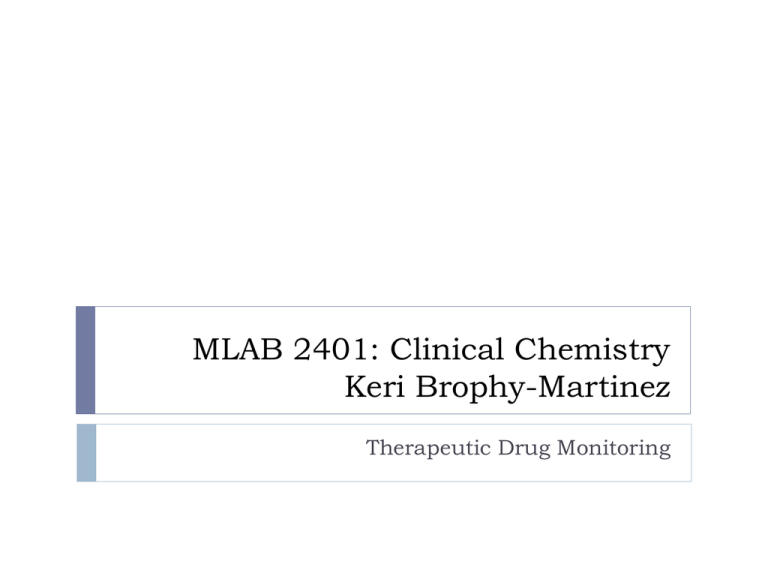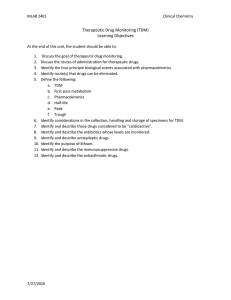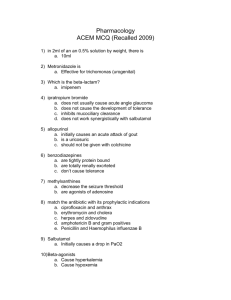MLAB 2401: Clinical Chemistry Keri Brophy-Martinez Therapeutic Drug Monitoring
advertisement

MLAB 2401: Clinical Chemistry Keri Brophy-Martinez Therapeutic Drug Monitoring Therapeutic Drug Monitoring= TDM Goal Ensure that a given drug dosage produces Maximal therapeutic benefit Minimal toxic adverse effects Must have an appropriate concentration at site of action that produces benefits Standard dosages derived from healthy population Only the free fraction of drugs can interact with site of action, resulting in a biologic response Routes of Administration Routes Injections Circulation= IV (intravenous) Muscles=IM (intramuscular) Skin= SC (subcutaneous) Epidermal Inhaled Absorbed through skin Rectal Oral (most common) Pharmacokinetics Involves the dynamics associated with the movement of drugs across cell membranes Includes biological events: Absorption Distribution Metabolism/Biotransformation Excretion Relationship of drug concentration to time Process assists in establishing or modifying a dosage regimen Absorption Rate at which drug leaves the site of administration and the extent to which this happens Mechanism Passive diffusion Active transport Absorption: Limiting Factors Oral Administration Absorption depends on.. Formulation of drug liquid/pill Intestinal motility pH Inflammation Food Presence of other drugs Patient age Pregnancy Concurrent Pathologic Conditions Distribution Dependent on Blood flow Capillary permeability Binding of drugs to proteins/Availability of free fractions pH gradients Lipid solubility of the drug Free vs. bound drug Tissue volume Metabolism Primarily occurs in the liver Biotransformation of the parent drug molecule into one or more metabolites Metabolites are: water soluble easily excreted by kidney or liver Pharmacologically active or inactive First-Pass Metabolism Elimination Elimination Routes Hepatic metabolism Renal filtration Other: skin, lungs, mammary glands and salivary glands Functional changes in organs can affect rate of elimination i.e. : Hepatic disease with a loss of tissue result in slow rate of clearance with a longer half-life. Elimination half-life The time required to reduce the blood level concentration to one-half after equilibrium is obtained. Pharmacokinetics Most drugs given on a scheduled basis not as a single bolus or mass Oscillation between a maximum(peak) and a minimum (trough)of serum concentration Goal of dosage regimens Achieve troughs in therapeutic range and peaks that are non-toxic Sample Collection Timing of TDM most important Collaborate with nursing & phlebotomy staff for appropriate timing Trough: right before next dose Peak: one hour post administration of dose (Verify drug protocol) Random Specimen Type Serum: no gel Plasma: Heparinized EDTA, Citrated, Oxalated not acceptable Whole Blood Saliva Drug Groups Cardioactive Antibiotics Antiepileptic Psychotherapeutic Antiasthmatic Immunosuppressive Antineoplastic Antihypertensive Drug Groups: Cardioactive Digoxin Used to treat CHF( congestive heart failure) Peaks draw at 2 hours post dose Inhibits sodium and potassium transport within the heart Allows for better cardiac muscle contraction and rhythm Lidocaine Used to treat premature ventricular contractions Affects the timing of cardiac contraction Drug Groups: Cardioactive (2) Quinidine Used to treat cardiac arrhythmic problems Inhibits sodium and potassium channels Prevents arrhythmias, atrial flutter and fibrillation Procainamide Used to treat cardiac arrhythmic situations Blocks sodium channels Affects cardiac muscle contraction Often measured with NAPA(N-Acetyl procainamide) Drug Groups: Antibiotics Aminoglycosides Used to treat infections with gram-negative bacteria that are resistant to less toxic antibiotics Inhibits protein synthesis of the micro-organism Examples include: gentamycin, tobramycin, amikacin and kanamycin Vancomycin Used to treat infections with more-resistant gram-positive cocci and bacilli Inhibits cell wall synthesis Drug Groups: Antiepileptics “AEDs” Most first and second generation AEDs used to treat seizure disorders and epilepsy First Generation Phenobarbital •Barbiturate Primidone is a proform Second Generation Felbamate Gabapentin Levetiracetam Phenytoin=Dilantin Oxcarbazpine Tigabine Valproic Acid= Depakene Topiramate Zonisamide Carbamazepine=Tegretol Drug Groups: Psychotherapeutic Used to treat manic depression (bipolar disorder) Lithium Tricyclic Antidepressants “TCAs” Clozapine Drug Group: Antiasthmatic Used to treat neonatal breathing disorders or respiratory disoders of adults or children, like asthma Examples include theophylline and theobromine Drug Group: Immunosuppressive Monitoring of this group of drugs important to prevent organ rejection (host-versus-graft) Used to treat autoimmune disease Examples Cyclosporine Whole blood is the specimen of choice, since it sequesters in the RBC Tacrolimus (Prograf) Prevents rejection of liver and kidney transplants Drug Group: Antineoplastics Inhibit RNA or DNA synthesis of tumor cells, leading to cell death Methotrexate Inhibits DNA synthesis Drug Group: Antihypertensive Used in treatment of high blood pressure Dilate blood vessels Sodium nitroprusside Used for short-term control of hypertension Techniques for Measurement of TDM Immunoassays Gas chromatography Liquid chromatography Mass spectrometry References Arneson, W., & Brickell, J. (2007). Clinical Chemistry: A Laboratory Perspective . Philadelphia, PA: F.A. Davis Company. Bishop, M., Fody, E., & Schoeff, l. (2010). Clinical Chemistry: Techniques, principles, Correlations. Baltimore: Wolters Kluwer Lippincott Williams & Wilkins. Sunheimer, R., & Graves, L. (2010). Clinical Laboratory Chemistry. Upper Saddle River: Pearson .



